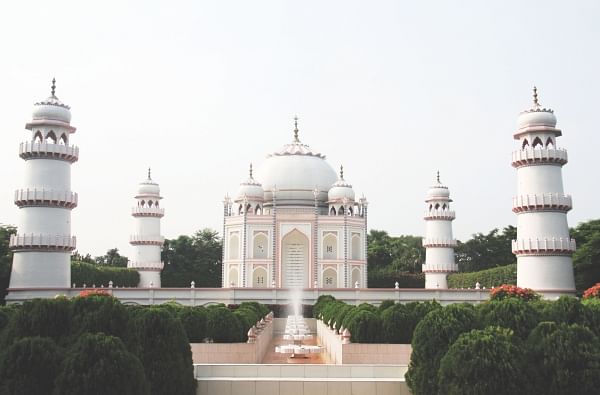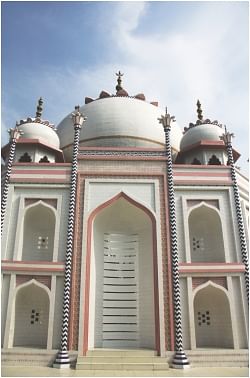| Home - Back Issues - The Team - Contact Us |
 |
| Volume 11 |Issue 39| October 05, 2012 | |
|
|
Musings
Taj Number 420 Sushmita S Preetha The first time I saw the Taj Mahal I was blown away by its sheer magnificence. Granted I was too young to appreciate the serenity and poetic significance of Shah Jahan's grand gesture to his wife, but even my young and uncultured mind didn't fail to grasp the overwhelming beauty that exuded from the stunning marble structure. The second time around, I was blown away by the Taj, once again. This time, however, it wasn't so much as its magnificence as a feeling of “wait… what?” that enveloped my senses. This time, I had opted to visit the Taj, not a few hundred miles away in the beautiful city of Agra, but that in our very own country, only 20 miles away from Dhaka, in Sonargaon. What a cheeky way to hand a blow to the Indians, I thought to myself, on my way there. If they think they can steal our water, we can show them by stealing their Taj Mahal! The Indians were furious, of course, when they heard we were building a Taj of our own; some high officials even threatened to sue us for copyright infringement. “You can't just go and copy historical monuments,” said a spokesperson at the Indian High Commission, huffing and puffing. But why not, we ask! If history repeats itself in different places at different times, why can't historical monuments? Infallible logic, surely. Infallible logic is what Ahsanullah Moni, the visionary behind Bangla's Taj, offered to the world to explain his decision to construct a 'copycat' Taj. "I am doing this only for the poor. They cannot travel. They cannot see this historical wonder," said Moni. "I also hope the landmark construction can attract more tourists from home and abroad." Before the unveiling in 2008, Moni, a wealthy Dhaliwood film-maker, had announced that he had spent as much as 400 crore taka ($58 million) to build his life-size replica. He had imported marble and granite from Italy, diamonds from Belgium and used 160 kilograms of bronze for the dome, he claimed. Cool. What an incredibly constructive way to waste, I mean, spend all that money for his fellow country-men! Yes, there were critics, the self-righteous kinds, who asked why he didn't make hospitals, schools or industries if he really wanted to do something for the country. Why didn't he contribute to preserving the local heritage sites in Sonargaon if he really were so bent on promoting tourism? But you know them critics, always looking to find flaws even in the most philanthropic of endeavours.
Needless to say, I was excited to behold this glorious structure – if nothing else, I'd get to see what it feels like to walk on 400 crore taka. The outside grounds of the Taj are very considerately lined with food and souvenir stalls, all authentically named after Momtaz, Akbar or some other famous Mughal ruler. I walked into Momtaz to sample the local Mughal cuisine. Some people might call the décor tacky, I call it carnivalesque, with its multi-coloured neon lights illuminating the painted delicacies on the wall. However, it was really the individual stalls, complete with their own sitting arrangements and a curtain to keep the unwanted spectator away that drew my attention. Oh, what a novel idea! What better way to celebrate the ultimate monument of love, the Taj, than to provide lovers a safe haven to enjoy each other, I mean, each other's company. As for the food, let's just say the only thing royal about it was the bill! In a souvenir shop, I noticed a selection of pink and white hats such as the ones worn by the memsahibs in British India (resembling in style only, not in quality). What an interesting juxtaposition, I thought. My friend, a historian, commented how the presence of the hats represented the British onslaught and eventual destruction of the Mughals. We paid Tk 50 each as entrance fee but we were humbled to see a signboard saying “All the money collected goes to benefiting the community”. The entrance to the Taj was decorated with blown-up, really low resolution, images of men and women, welcoming you with open arms and pointing in the direction of the Taj. We were charmed. And then we saw the Taj. It was not life-sized. In fact, I don't think it was even one-third its original size. It certainly didn't look much like the Taj if one considers the dimensions and the architectural inaccuracies. But what was really awesome, in my view, was that the whole structure was made with what looked suspiciously like bathroom tiles. The diamonds, marbles and granite were nowhere to be seen. How subversive, commented the historian, looking around. “This particular interpretation of the Taj Mahal really does subvert the assumptions of the dominant style through chaos. Calls into question everything we know and believe to be True,” she observed. The carnivalesque nature of the Taj was further solidified by the photo-narrative of 1971 created by the ever-talented Moni, showcased on the walls of a café situated within the premises of the Mahal. At first glance, we thought they were gory photographs of the Liberation War, but on further scrutiny, we realised that they were all fake pictures, with people posing for them in chains, covered in artificial blood. The pictures were so raw and so disturbing that we didn't really know what to make of them or the fact that he had recreated the war in his studio. The other walls were adorned with random images of women, supposedly actresses who featured in his films. We sat in the “reflection” area, overlooking the Taj, and contemplated the magnificence we had just beheld. Perhaps it is elitist of us to laugh so at the joke that was the Bangla Taj after all, for a lot of people in Dhaka and elsewhere, it is one of a handful of places where you can go to for entertainment and a breath of fresh air. But to call it an exact replica of the Taj, claim that he spent 400 crore taka to recreate it and make a fortune from it really calls into question the integrity and taste of the maker. But was it worth the trip? Absolutely! Copyright
(R) thedailystar.net 2012 |

